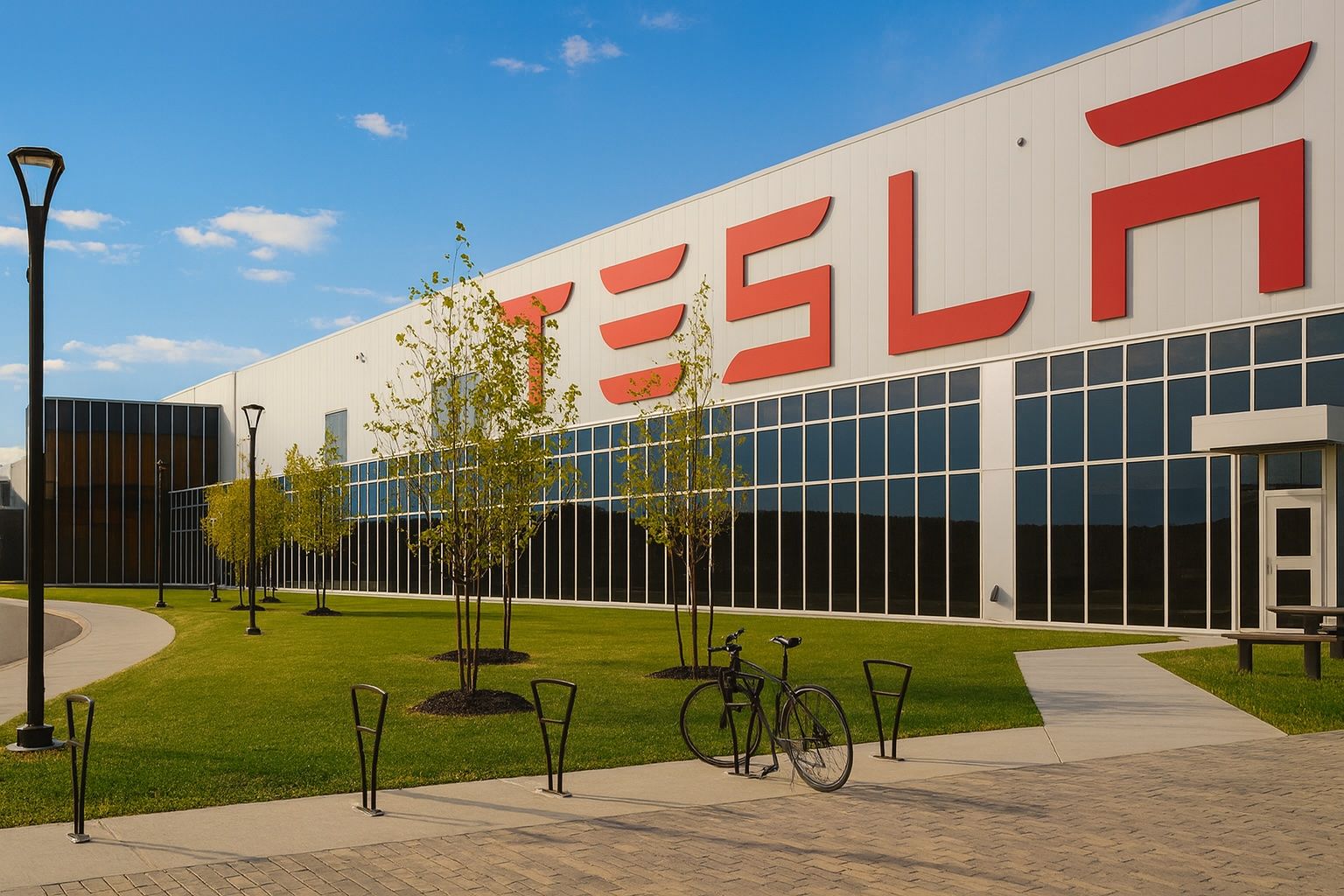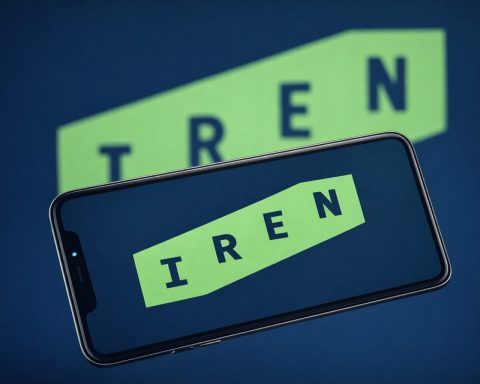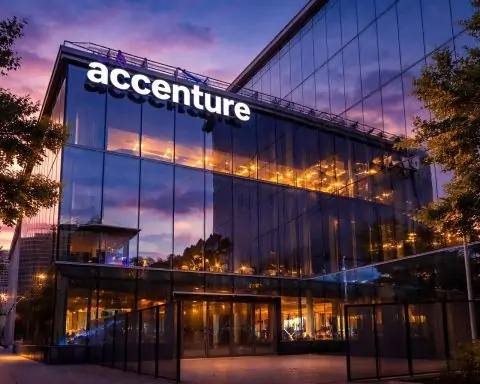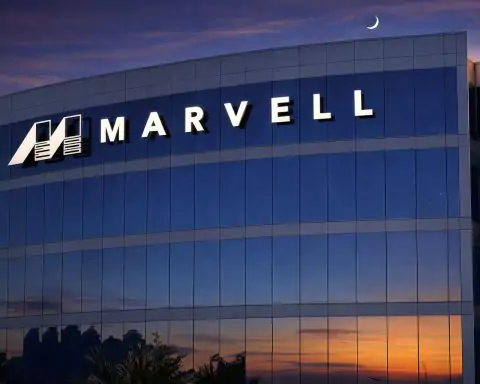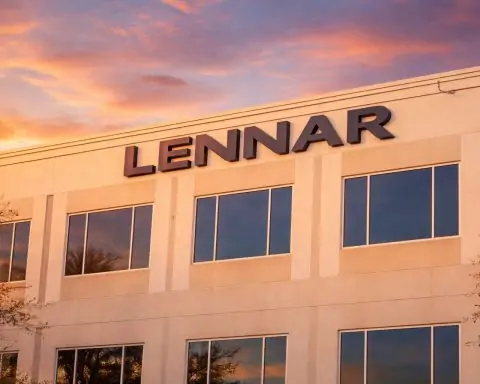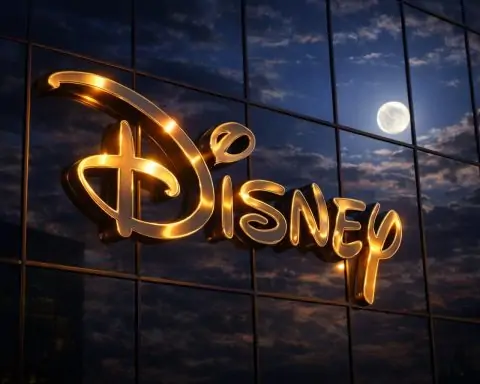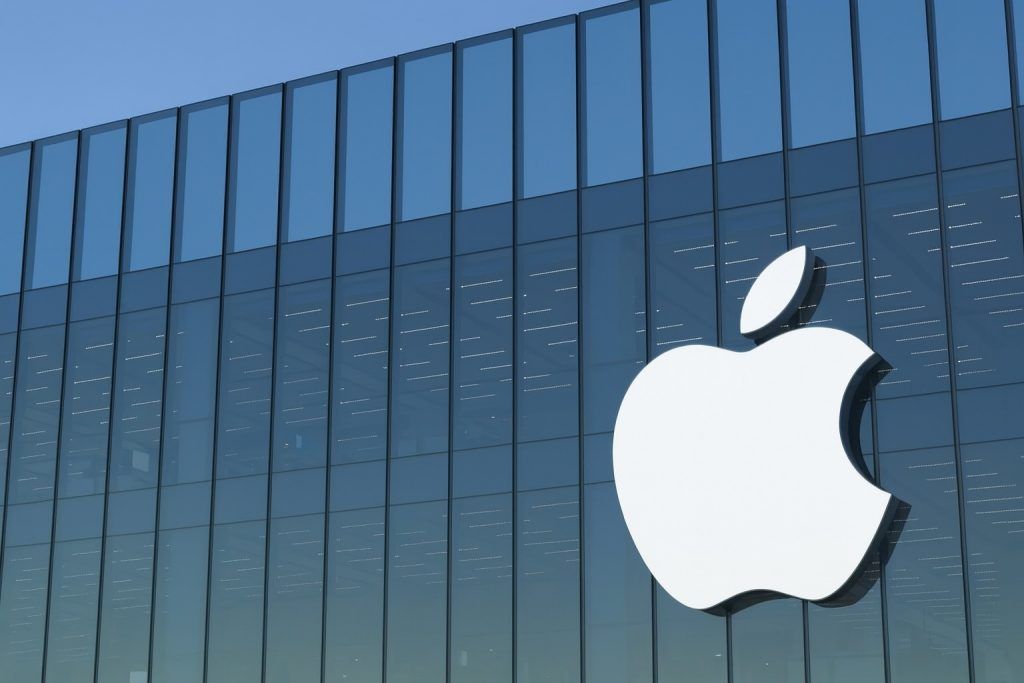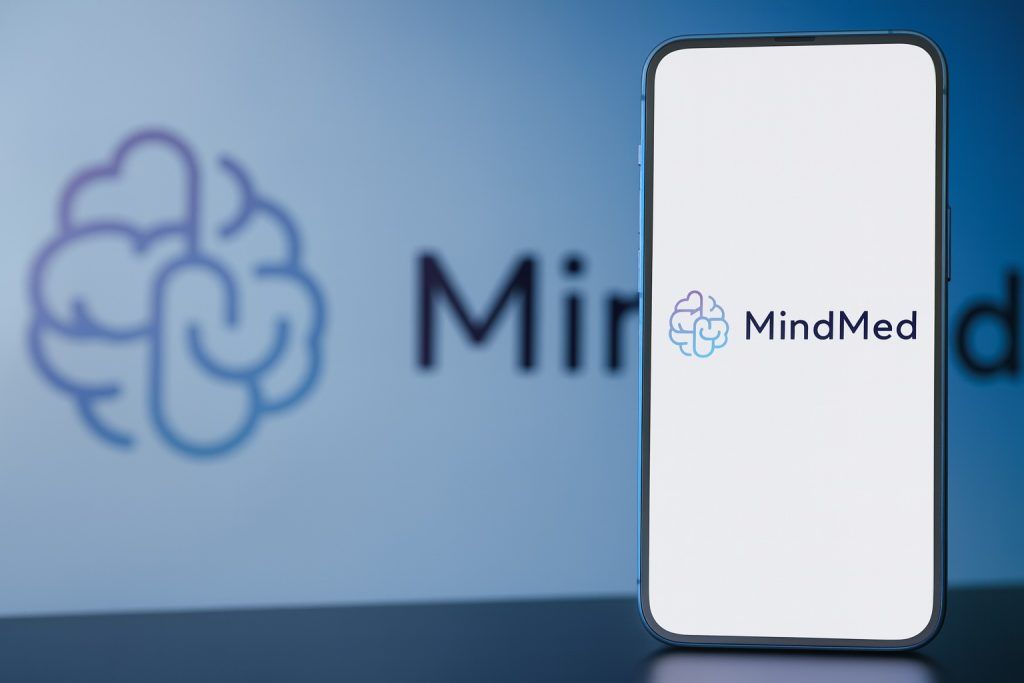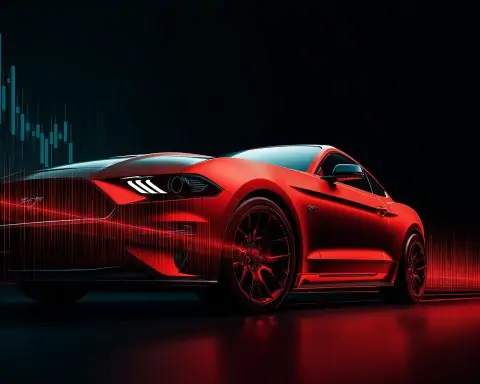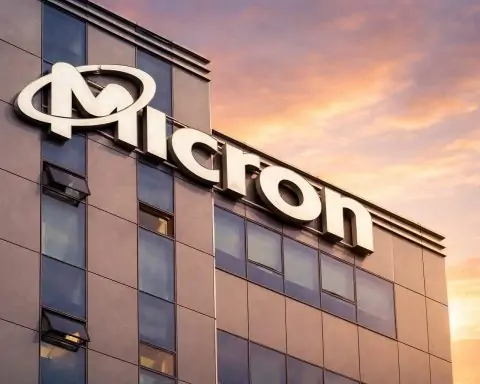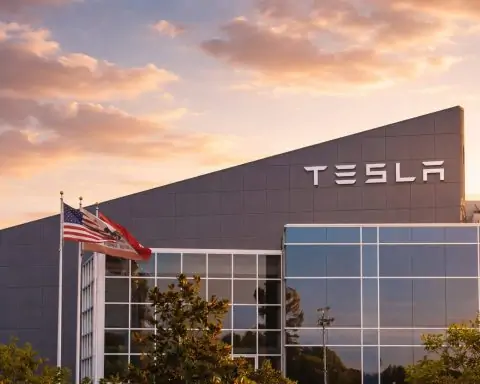- New Tesla for ~$35K: Tesla built the first units of a long-promised affordable EV (a pared-down Model Y) in mid-2025, aiming for a starting price around $30–35K [1]. CEO Elon Musk hinted this budget model is essentially “just a Model Y” with fewer features [2]. Cybertruck deliveries also finally resumed in April 2025 after delays [3], and Tesla is eyeing future “Cyber” variants like a full-size Cyber SUV [4].
- Autopilot in the Crosshairs: U.S. regulators opened a safety probe into Tesla’s Full Self-Driving (FSD) software amid 50+ reports of cars running red lights or going the wrong way, linked to 14 crashes and 23 injuries [5] [6]. Tesla, meanwhile, rolled out a major FSD v14 update with new driving modes (from a slow “Sloth” mode to a high-speed “Mad Max” mode) and better handling of hazards [7] [8]. Early testers praise its decisiveness in heavy traffic [9] even as authorities scrutinize FSD’s real-world safety.
- Musk’s AI Pivot: Musk disbanded Tesla’s “Dojo” supercomputer project in Aug 2025, refocusing resources on next-gen AI5 and AI6 chips for Autopilot and the Optimus robot [10]. “It doesn’t make sense…to divide [Tesla’s] resources” on two different AI chip efforts, Musk said, adding that upcoming in-house chips will be “excellent for inference and…pretty good for training” AI models [11]. Tesla inked a $16.5B deal with Samsung to supply its advanced AI6 chips [12], which will power self-driving features and Tesla’s humanoid Optimus robots [13].
- Global Expansion & Leadership: Tesla opened its first showroom in India (Mumbai) in July 2025 [14] – a milestone after years of courting the world’s #3 car market. Giga Berlin began exporting right-hand-drive Model Y SUVs to India [15] as Tesla explores a potential $2B factory there (a Tesla team visited India to scout sites under new tax-break incentives) [16]. Internally, Tesla saw leadership shake-ups: e.g. Musk confidant Omead Afshar, who oversaw North America and Europe, left in mid-2025 [17] amid a string of executive exits. The company also cut thousands of jobs as part of a reorg, while doubling down on its AI-driven projects and robotics [18]. Musk’s hands-on role across his ventures (Tesla, SpaceX, X, etc.) has drawn some criticism, but Tesla insists its core mission remains on track.
New Vehicles and Product Releases
Tesla’s vehicle lineup is evolving rapidly. In late 2025 the automaker is rolling out a cheaper EV to broaden its market. Tesla confirmed it built “first builds of a more affordable model” in June 2025 and plans volume production in the second half of 2025 [19]. Musk described the new car as basically a stripped-down Model Y crossover [20] – likely with a smaller battery and fewer frills to hit the mid-$30K price band (versus ~$45K for today’s base Model Y). Early reports (and spy photos) suggest it will share the Model Y’s platform under an internal project code “E41,” achieving 20%+ cost reduction per unit [21] [22]. If Tesla meets its target, first deliveries of this budget model could begin by Q4 2025 [23], significantly expanding Tesla’s addressable market. Analysts note this move could help stem Tesla’s recent sales dip by attracting new buyers, though it may also cannibalize some Model 3/Y sales [24]. “Model 3 transformed Tesla’s business…a $30K Tesla could boost volume”, observes one market watcher, but warns the company is “matching the competition…rather than revolutionizing” this segment [25] [26].
Meanwhile, Tesla’s long-awaited Cybertruck is finally hitting the streets – albeit fashionably late. After delivering a handful of Cybertrucks in late 2023, Tesla resumed customer deliveries in April 2025 with a “Long Range” RWD version [27]. This stainless-steel pickup now starts around $69,990 (after a price hike) but ships without some initially touted features in order to streamline production [28]. Musk openly acknowledged the production challenges for the angular truck, calling its 2023 ramp “enormously difficult.” Despite the hurdles, Tesla is doubling down on the “Cyber” design language: Chief Designer Franz von Holzhausen revealed Tesla has considered developing both a full-size “Cyber SUV” and a smaller Cybertruck for global markets [29]. In other words, Tesla may adapt the Cybertruck’s radical aesthetic into a more conventional 7-seat SUV and a scaled-down pickup suitable for regions like Europe [30]. (Notably, Musk indicated Tesla won’t reuse Cybertruck’s pricey stainless-steel exoskeleton on other models [31] – so any Cyber SUV might look like the truck but use cheaper materials.) These future variants remain conceptual, but they underscore Tesla’s intent to build an entire sub-brand of cyber-styled EVs in coming years.
Other vehicles on Tesla’s roadmap include the long-delayed Roadster (2nd generation) and the Tesla Semi. The new Roadster sports car – first shown in prototype form back in 2017 – is now expected to enter production in 2025 (as a 2026 model) [32]. With a rumored 620-mile range and blistering 0–60 mph under 2 seconds, the Roadster will start around $200,000 [33]. It’s a niche halo product (more about bragging rights and tech prowess than sales volume), but it highlights advances in Tesla’s battery and performance engineering – Musk quipped it may even offer a SpaceX package with cold-gas thrusters. On the commercial side, Tesla’s battery-powered Semi truck is finally gearing up for volume production after years of teases. A dedicated Semi assembly line has been set up at Giga Nevada, and Musk confirmed mass production begins in 2026 [34]. Tesla aims to build 50,000 Semis per year at full capacity [35], supplying customers who placed early reservations (like PepsiCo). Only limited test batches have been delivered so far, but new equipment installations at the Nevada factory signal that Tesla is serious about electrifying heavy freight [36]. The Semi’s rollout will mainly impact commercial fleets (with ~$150k–180k pricing depending on range) [37], yet it’s a key piece of Tesla’s mission to decarbonize “everything on wheels.”
Autopilot & Full Self-Driving: Upgrades Under Scrutiny
Tesla’s Autopilot and Full Self-Driving (FSD) systems remain a central focus – delivering cutting-edge features to owners, but also drawing intensifying scrutiny from regulators. In mid-October 2025, Tesla began wider deployment of its new FSD version 14 software to the general owner fleet [38] [39]. This update – the first major FSD overhaul in a year – had previously been limited to a small Early Access group. FSD v14 introduces a suite of new capabilities aimed at improving both safety and user experience. Notably, it added a cautious driving profile nicknamed “Sloth” mode for more defensive, gradual maneuvers [40], as well as the ability for the car to auto-park at a driver-designated spot at the destination [41]. Tesla also upgraded the visualization and planning logic: FSD v14 can now navigate parking garages, yield properly for emergency vehicles, recognize and avoid road debris, and generally provide a smoother ride with less jerky behavior [42]. These improvements, according to Tesla, make v14 the most capable FSD build yet – an assertion backed up by early testing feedback. As the rollout expanded, Tesla pushed a minor update (v14.1.2) that unlocked a high-speed “Mad Max” mode – essentially a more aggressive setting that allows higher speeds and assertive lane changes [43]. Initial reviewers have raved about the Mad Max profile’s performance, saying it handles dense traffic and congestion decisively, with far less hesitation than prior FSD versions [44]. Many owners welcomed these refinements, which together aim to make the driver-assist system feel more human-like in both calm and demanding scenarios.
However, even as Tesla touts FSD’s advancements, regulatory bodies are ramping up oversight on the technology’s real-world safety record. On October 9, 2025, the U.S. National Highway Traffic Safety Administration (NHTSA) opened a formal investigation into 2.88 million Tesla vehicles equipped with FSD [45]. The probe came after 58 reported incidents of Tesla cars on FSD engaging in traffic violations or erratic behavior, including 14 crashes and 23 injuries tied to the software [46]. NHTSA officials cited cases of Teslas blowing through red lights and making improper lane changes (such as driving against oncoming traffic) while FSD was active [47] [48]. In one crash detailed in agency filings, a Tesla on FSD rolled into an intersection on a red light and was struck by cross traffic [49]. The safety agency pointedly noted that FSD has “induced vehicle behavior that violated traffic safety laws.” [50] This strong language signals regulators’ concern that FSD’s decision-making may be fundamentally deficient in certain scenarios. The investigation is currently a Preliminary Evaluation, the first step that could lead to a recall if NHTSA determines FSD poses an unreasonable safety risk [51]. Tesla has already responded by pushing an over-the-air software update to FSD in an attempt to address some of the flagged issues [52]. (The specifics of the update were not fully detailed, but presumably target the red-light behavior and other anomalies.) Musk maintains that FSD, while not perfect, is improving rapidly and argues that it reduces overall crash rates when properly supervised. Yet, the new NHTSA probe joins several ongoing investigations into Tesla’s driver-assistance tech – including earlier NHTSA inquiries into Autopilot crashes with emergency vehicles, and a Department of Justice probe into FSD marketing claims. Legal pressure is mounting: Tesla faces civil lawsuits from some accidents allegedly involving Autopilot/FSD, and California’s DMV has accused the company of misleading advertising (leading Tesla to drop the name “Full Self-Driving” for “Autonomous” in that state’s marketing). Bottom line: Tesla’s push toward autonomy is at a critical juncture – software breakthroughs are arriving, but so is regulatory backlash demanding proof that these robo-chauffeurs are safe for public roads.
In response, Tesla is expanding its efforts to prove FSD in the field (and perhaps appease regulators through real-world data). The company has been running pilot projects for robo-taxis under the codename “Cybercab.” In Austin, Texas – where Tesla is headquartered – a limited fleet of Model Y “robotaxis” (each with a safety driver onboard) has been quietly ferrying Tesla employees to gather data [53]. And beyond Texas, Musk claims Tesla is “getting regulatory permission” to test or deploy autonomous ride-hailing in a growing list of states, including California, Nevada, Arizona, and Florida [54]. In fact, Tesla recently secured a special permit in Nevada to run driverless car trials on public roads [55]. Musk has boldly predicted that Tesla could offer robotaxi services to “half the [U.S.] population” by the end of 2025 – if pending approvals come through [56]. Most experts view that timeline with skepticism, noting fully driverless fleets at scale are likely years away. Still, Tesla’s strategy is to incrementally roll out autonomous capabilities city by city, proving the tech (and its safety) to both regulators and the public. The coming year will be pivotal for FSD’s reputation: Tesla will either demonstrate that its latest AI can handle complex urban driving or face pressure to rein in its self-driving ambitions. As a safety advocate at Consumer Reports put it, “Tesla’s beta tests are happening on public roads – and everyone is a participant, whether they opted in or not.” The stakes for Tesla, and the entire autonomous vehicle industry, have never been higher.
AI and Robotics: Dojo Down, Optimus Up
Beyond the consumer-facing software, Tesla’s behind-the-scenes AI program underwent a major shift in 2025. In August, news broke (via Bloomberg) that Elon Musk ordered the shutdown of Tesla’s “Dojo” supercomputer team [57]. Dojo was an ambitious in-house project to build a giant AI training computer (using custom Tesla-designed chips) for FSD video data. It had been hyped at Tesla’s AI Day events as a game-changer for neural network training. But Musk abruptly disbanded the Dojo engineering group, with its leader (veteran chip architect Peter Bannon) leaving the company [58] [59]. In an X (Twitter) post, Musk explained the decision: “It doesn’t make sense for Tesla to divide its resources and scale two quite different AI chip designs,” he wrote [60]. Tesla had already been developing next-generation “HW4/HW5” inference chips for use in car onboard computers. Musk essentially chose to streamline Tesla’s AI chip efforts, focusing on these Tesla AI5 and AI6 chips (used for running AI models in real time in vehicles and robots) and scrapping the separate Dojo training chip initiative [61]. All effort is focused on the unified chip roadmap now, Musk emphasized [62].
This pivot was striking because just a year prior, analysts at Morgan Stanley had gushed that Dojo could add “$500 billion” to Tesla’s market value by opening new AI/cloud services [63]. Yet Musk evidently decided Dojo’s custom hardware wasn’t worth the continued investment – especially amid talent turnover. (Notably, around 20 AI engineers left Tesla to form a startup, DensityAI, shortly before Dojo was axed [64].) Instead, Tesla will rely on more off-the-shelf solutions and its upcoming HW5/AI5 chips for training, supplemented by external GPU clusters as needed. Musk insists Tesla’s internally designed AI5/AI6 chips will be “pretty good” at training as well [65], even if they’re optimized for in-car inference tasks. And Tesla isn’t abandoning AI compute by any means – it recently announced a $16.5 billion deal with Samsung to manufacture the advanced AI6 chips in coming years [66]. These chips are expected by around 2026 and will likely power the next generation of Tesla vehicles’ self-driving hardware, replacing the current FSD Computer. Musk also noted that the AI6 and future chips won’t just go into cars: they’ll be used in Tesla’s “Optimus” humanoid robots and potentially for broader AI applications beyond vehicles [67]. In other words, Tesla is aligning its silicon development to serve both autonomous driving and robotics with one unified architecture.
Speaking of Optimus, the Tesla Bot project is quietly progressing. While far less publicized than Tesla’s vehicles, the bi-pedal humanoid robot prototypes have steadily improved since their debut in 2022. Tesla occasionally shares glimpses of Optimus performing simple tasks – for instance, the robot can now walk, manipulate small objects, and even execute a slow “dance” in demonstration videos (albeit with a touch of awkwardness). At Tesla’s Fremont AI Lab, multiple Optimus units have been spotted assembling another Optimus robot, showcasing self-replication lite as a proof of concept. Musk has stated that Optimus (designed to do “unsafe, repetitive or boring” tasks) could eventually “transform civilization” with a potential market “larger than cars.” For now, that remains aspirational, but Optimus prototypes are serving as a testbed for Tesla’s AI prowess. Notably, the same vision and actuator control software that Tesla develops for FSD is being adapted to help Optimus perceive and navigate the human world. And thanks to Tesla’s latest AI chips, each robot could be equipped with powerful neural networks. Musk recently said Tesla’s future AI chips (like HW5/6) will be deployed in Optimus humanoids and give them significant onboard intelligence [68]. In 2025, Tesla began optimistically advertising job openings for “thousands” of Humanoid Robot assembly workers in the coming years – signaling plans to eventually mass-produce Optimus when the technology matures. While a walking, talking household Tesla robot is still some way off, the company’s integrated approach to AI – spanning cars, robots, and custom silicon – could yield unexpected synergies. As one AI engineer quipped, “If your car can learn to drive itself in the real world, maybe your robot can learn to tidy the garage too.”
Gigafactories & Manufacturing: Ramping Up and Re-tooling
To support its product plans, Tesla is expanding and fine-tuning its global manufacturing footprint. One major development is in Germany: Giga Berlin-Brandenburg (Tesla’s European factory) received approval in mid-2024 to expand its production capacity significantly [69]. Environmental regulators in Brandenburg gave Tesla a green light to extend the existing factory site, paving the way to double Giga Berlin’s output from ~500,000 to ~1,000,000 vehicles per year [70]. This expansion involves building additional production facilities (and even a railyard for shipping cars) on Tesla’s land. It’s a big victory for Tesla, which faced intense scrutiny from German environmental groups when initially building Giga Berlin. (Activists staged protests and even committed an arson attack on a power supply line in March 2024 that briefly halted the factory [71].) By sticking to its current site for growth, Tesla avoided further deforestation and appeased some critics [72]. Giga Berlin currently produces the Model Y crossover for Europe and some export markets. In March 2025, the plant hit a milestone of 500,000 vehicles produced since opening – achieved in just about 2 years of operation, thanks to its rapid ramp-up. Tesla’s internal goal is now to push Giga Berlin toward peak capacity (one million units annually) over the next couple of years, which would make it one of the highest-output auto plants in Europe. There are also plans to add battery cell manufacturing on-site. Notably, Giga Berlin has started assembling right-hand-drive Model Ys for the Indian market [73], marking Tesla’s first exports to India while that market is tested.
In the United States, the focus is on maximizing capacity at existing factories rather than immediately building new ones. In April 2024, Tesla surprised observers by announcing it would delay new factory investments (like the proposed Mexico plant) and instead build new models using existing production lines [74]. “We will use our current factories to build the new affordable vehicle,” Musk’s team said, indicating that facilities such as Fremont (California), Giga Texas, Giga Shanghai, and Giga Berlin will be retooled to handle new models coming in late 2025 [75]. This strategic shift put the much-hyped Monterrey, Mexico Gigafactory on the backburner for now [76]. (Tesla had announced the Mexico factory in early 2023, with plans to produce a next-gen $25K car there, but economic uncertainty and cost concerns led to a pause [77].) Instead, Tesla says it wants to increase output by ~50% using its current plants – which would take total capacity from ~2 million to nearly 3 million cars per year – before committing to new sites [78]. “It’s more capex-efficient to grow vehicle volumes from existing facilities during uncertain times,” the company noted [79]. This move reassured some investors who worried Tesla might overextend on new construction. For example, Giga Texas (Austin), which opened in 2021, still has substantial unused floor space that Tesla can utilize. Indeed, Giga Texas is now ramping up production of new models – it handles the Cybertruck assembly and is likely to produce the new affordable Model Y variant as well. Recent reports suggest Giga Texas is also trial-producing an updated Model Y “long range” variant with new battery technology, as Tesla constantly iterates its lineup.
Tesla hasn’t completely shelved expansion dreams, though. The company continues to scout new international locations. In India, where Tesla just set up shop with its first showroom, Musk has repeatedly expressed interest in a factory if conditions allow. After years of impasse over India’s high import tariffs, the Indian government in 2023 offered incentives (lower taxes for automakers investing at least $500M in local production) [80]. This spurred Tesla to send a team to explore factory sites in India in 2024 [81]. Rumor has it Tesla is eyeing several Indian states for a potential EV plant (with an investment around $2 billion) [82]. As a stopgap, Tesla can import up to 8,000 cars a year at reduced duty under the new program [83], which is why Giga Berlin is building Indian-spec Model Ys to kick-start sales in India without waiting for a local plant [84]. Musk has called an India factory “highly likely” in the long term, though he cancelled a meeting with the Indian Prime Minister in 2024 citing “heavy workload” [85]. Elsewhere, speculation persists about Tesla eventually needing additional factories in regions like Canada or Southeast Asia to reach its goal of 20 million cars/year by 2030. For now, however, Tesla’s strategy is sweating its assets – wringing more production out of Fremont (which makes Models S, X, 3, Y), Shanghai (Models 3, Y), Texas (Model Y, Cybertruck), and Berlin (Model Y). Each of these Gigafactories is among the most productive auto plants on their continents, thanks to Tesla’s high degree of vertical integration and simplified vehicle designs.
In terms of manufacturing innovation, Tesla is also refining its techniques. The company pioneered the use of giant casting machines (“Giga Presses”) to form large unibody sections of its cars, reducing complexity. In 2025, Tesla filed patents for an even more advanced process to die-cast nearly an entire vehicle frame as one piece – a bold idea that could drastically speed up assembly (though some experts are skeptical of its feasibility for mass production). Additionally, Tesla continues to iterate on its 4680 battery cell production. After initial struggles scaling 4680 output in Texas, yields have improved, and those cells are now going into some Model Y units and the Cybertruck packs. If Tesla can ramp the 4680 line to volume, it could lower battery costs and increase vehicle range. In sum, Tesla’s manufacturing game plan for late 2025 and beyond is twofold: optimize and enlarge current Gigafactories, and incorporate new production tech (like bigger castings and structural battery packs) to build more cars with fewer factories. This approach is a balancing act – delaying new plants saved capital in the short term, but Tesla will eventually need more footprints to keep growing. Industry observers are watching to see if Tesla announces any new Gigafactory locations in 2026, once its next model launches are underway.
Charging Network & Partnerships
When it comes to EV charging infrastructure, Tesla has turned its once-proprietary network into a quasi-standard – a strategic coup that unfolded over 2024–2025. Historically, Tesla’s Supercharger network was a closed ecosystem, using the Tesla-specific plug in North America (now called the North American Charging Standard, or NACS). That changed dramatically as other automakers, frustrated with unreliable third-party chargers, decided to embrace Tesla’s charging technology. In mid-2023, Ford Motor Co. shocked the industry by announcing a deal to adopt Tesla’s NACS connector for its future EVs and gain access to Tesla’s Superchargers. General Motors followed suit weeks later. By 2025, nearly every major U.S. automaker had joined this movement: from luxury brands like Mercedes-Benz and Audi to mass-market players like Nissan, Honda, Volvo, Rivian, and Hyundai/Kia, all agreed to integrate the Tesla-derived plug on new EVs starting in 2025–2026 [86] [87]. This means a Ford Mustang Mach-E or GM Chevrolet Blazer EV will be able to charge at any of Tesla’s 17,000+ Supercharger stalls across North America just as easily as a Tesla vehicle [88] [89]. In the interim, those automakers are providing adapters for existing owners to use Superchargers [90] until native NACS ports roll out. It’s hard to overstate how much this “Great NACS Migration” [91] transforms the EV landscape. By uniting around Tesla’s connector (now an SAE-approved standard), the industry is converging on one charging format, which should vastly simplify public charging. EV owners will no longer worry about incompatible plugs or carrying multiple adapters; charging networks can streamline equipment; and Tesla enjoys both licensing revenue and the PR boost of having built the most reliable charging system that even competitors rely on.
In parallel, Tesla opened portions of its Supercharger network to non-Tesla EVs more directly. Using government incentives, Tesla installed “Magic Dock” adapters at hundreds of Supercharger stations, enabling any CCS-equipped car to plug in. This was part of a deal with the Biden administration to qualify Tesla for federal funding (under the NEVI program) – Tesla committed to make 7,500 Supercharger plugs open to all EVs by end of 2024, and it has been steadily retrofitting sites to meet that goal. Moreover, charging consortiums are now copying Tesla’s playbook. In July 2023, a group of seven automakers (BMW, GM, Honda, Hyundai, Kia, Mercedes, and Stellantis) announced a joint venture to build 30,000 new fast chargers in North America, starting in 2024. Tellingly, this coalition – now named “Ionity North America” or IONNA – will equip their stations with both CCS and NACS connectors, effectively acknowledging NACS as a required standard. The first of these JV chargers are slated to come online in late 2024 at key highway locations and urban centers, with a focus on reliability and amenities (the automakers promise stations with canopies, restrooms, and restaurants nearby). While this network will technically compete with Tesla’s, it indirectly extends Tesla’s influence, since many of its plugs will be Tesla-designed.
Tesla also forged more traditional partnerships to extend charging access. For instance, it struck agreements with major fuel/travel plaza chains – Pilot/Flying J and Love’s – to install Superchargers at dozens of highway travel centers, leveraging their convenient locations. Starbucks and Volvo teamed up with ChargePoint to deploy chargers along certain routes, but even those are now being specced with NACS. And Tesla is not shy about commercializing its charging tech: it now sells Universal Wall Connector home chargers that include both a Tesla plug and a J1772 adapter in one unit, appealing to households with mixed EV brands. Hotels and resorts are another growth area – Hilton announced in September 2023 that it will install up to 20,000 Tesla Universal chargers at its properties in North America, so guests can easily charge overnight.
All these moves bolster Tesla’s Supercharger network, which remains the gold standard for fast charging. Superchargers are now in every U.S. state and most Canadian provinces, and Tesla has expanded into Australia, many parts of Asia, and all over Europe (where it uses the CCS2 plug). In fact, in Europe and China, Tesla had already opened its chargers to other EVs by adopting local standard plugs earlier. With NACS now going global (Ford and GM plan to also use it in China and other markets eventually), Tesla’s charging lead could translate into a lasting competitive moat. The company’s strategy seems to be: make Supercharging ubiquitous and profitable, even if that means helping rival EVs, because it encourages more EV adoption (and Tesla tends to benefit as the market leader). According to Tesla, Supercharger usage by non-Tesla cars is rising steadily each quarter in pilot locations. And starting in 2025, we’ll see the first non-Tesla models rolling off assembly lines with native NACS ports – a clear win for Tesla’s approach.
Aside from charging, Tesla’s partnerships extend to other domains as well. In 2025 Tesla partnered with various global suppliers to secure critical materials: deals for lithium (with Piedmont Lithium, Albemarle), nickel (with Indonesian and Canadian mines), and other battery metals ensure its supply chain for the next few years of growth. Tesla also deepened ties with Panasonic and CATL for battery cell supply, even as it produces more cells in-house. On the energy front, Tesla is collaborating with utilities for grid storage projects (e.g., a massive 2 GWh Megapack installation with Southern California Edison). And in tech, Tesla’s influence shows in companies like NVIDIA and AMD supplying chips for older Autopilot systems, while Tesla’s own breakthroughs (like its Dojo software techniques) have attracted interest from cloud computing firms. Elon Musk’s sway as a tech figure also means Tesla often partners informally with his other ventures – for instance, using SpaceX Starlink satellite internet to connect remote Supercharger stations.
One notable partnership to mention: in 2025 Tesla signed a contract with Samsung Electronics to manufacture its upcoming AI6 self-driving chips on Samsung’s cutting-edge semiconductor lines [92]. This huge ~$16B deal not only secures Tesla a supply of advanced silicon for years, but also signals a partnership between two industry giants (Tesla and Samsung) against a common rival (Taiwan’s TSMC, which dominates advanced chipmaking). It’s unusual for an automaker to negotiate such a large semiconductor purchase, underlining Tesla’s self-image as much a tech company as a carmaker.
Overall, Tesla’s network of alliances and standards in 2025 show a company leveraging its early mover advantages. By opening its ecosystem (in a controlled way), Tesla turned competitors into customers – licensing its charging standard and attracting billions in partner investment that indirectly benefit Tesla owners. Few could have imagined a few years ago that Ford EVs would charge with Tesla plugs at GM-built stations, yet here we are. This strategy strengthens Tesla’s brand and might generate substantial high-margin revenue (through charging fees and NACS licensing) down the road. It’s a classic Elon Musk play: make your product so appealing that even rivals adopt it, and in doing so, expand your empire’s reach.
Tesla Energy: Solar, Storage & Virtual Power Plants
While Tesla is best known for cars, its energy business has quietly become a powerhouse of its own. Tesla Energy encompasses solar photovoltaics (solar panels and the Solar Roof) and energy storage products (the Powerwall home battery, and Megapack utility-scale battery units). As of late 2025, the energy division is hitting record growth, driven especially by Megapack deployments. In fact, 2024 marked a tipping point where Tesla’s storage business flourished despite a slump in automotive revenue [93]. In 2024 Tesla deployed 31.4 GWh of battery storage (mostly Megapacks) – a 67% jump from the prior year, reaching $10.9 billion in sales [94]. By comparison, Tesla’s automotive revenue fell 6% that year amid price cuts, meaning energy is an increasingly important pillar. The gross margins on energy storage also surpassed vehicle margins (26% vs 18% in 2024) [95], highlighting that batteries can be a very profitable business. Musk has repeatedly stated that in the future, Tesla’s stationary storage could equal or exceed its vehicle business in size, as the world needs massive batteries to buffer renewable energy on the grid.
To meet soaring demand, Tesla rapidly expanded production of Megapacks. A signature achievement was the construction of a dedicated Megafactory in Shanghai, China, which went from groundbreaking to operation in mere months. Tesla broke ground on the Shanghai energy plant in late May 2024 and astonishingly had it built by December; by February 2025 the factory started production of its first Megapack units [96] [97]. This facility – Tesla’s first energy storage plant outside the U.S. – is designed to output 10,000 Megapacks per year at full capacity (about 40 GWh of storage annually) [98]. For perspective, that is nearly equal to the entire world’s grid storage deployments in 2022. Each Megapack is a container-sized battery module (3 MWh+ each) used for large-scale projects like replacing peaker power plants or stabilizing wind/solar farms. At the opening ceremony of the Shanghai Megafactory, Tesla’s VP of Energy Mike Snyder emphasized the mission: “We are committed to building energy products in synergy with electric vehicles to accelerate the world’s transition to sustainable energy.” [99] He noted that the new factory would “help Tesla expand into additional markets” for energy storage [100]. Indeed, having a production base in China should enable Tesla to supply Asia and Europe more easily (and tap into China’s battery supply chain). By Q3 2025, reports indicated Tesla’s Shanghai Megapack plant had already produced hundreds of units and was scaling fast amid a battery price war with Chinese competitors [101]. (Chinese companies like CATL and BYD have slashed prices for large battery projects, undercutting Tesla’s Megapack bids in some cases [102]. The competition is fierce, with some local integrators offering turnkey storage at a fraction of Tesla’s cost per kWh [103]. Tesla responded by cutting Megapack prices 50% in China over 2024 [104], leveraging economies of scale from the new factory.)
In the U.S., Tesla’s original Megafactory in Lathrop, California is also running at high output, reportedly able to make 10,000+ Megapack units per year as well. Together, these facilities position Tesla as a global leader in grid batteries just as utilities and corporations invest heavily in energy storage. Notable recent projects include a 360 MWh Megapack farm in Alaska (helping an isolated grid retire diesel generators) and a 2 GWh storage system in Texas to support ERCOT (the state grid) during peak summer demand. Tesla is effectively selling giant batteries as a service – many Megapacks are sold with long-term maintenance and software subscriptions (Tesla’s Autobidder software, which uses AI to optimize energy trading and battery dispatch, is frequently bundled). This provides recurring revenue and sticky relationships with power providers.
On the residential side, Tesla’s Powerwall battery and solar solutions continue to gain traction, especially as extreme weather and outages spur interest in home backup power. In California, Tesla has a partnership with utilities like PG&E for a Virtual Power Plant (VPP) program that networks Powerwall-equipped homes to send power back to the grid at critical times. In July 2025, during heat waves, Tesla’s California VPP delivered an impressive 535+ MW of emergency capacity to the grid – “enough to power half of San Francisco,” the company noted [105]. Of that, nearly 500 MW came from homeowners’ Powerwalls discharging simultaneously [106], showcasing the sheer scale of Tesla’s installed base of batteries. These orchestrated events helped the grid avoid blackouts and earned participating households substantial credits. Similarly, in Puerto Rico, where Tesla deployed many Powerwalls after Hurricane Maria, a Tesla VPP in 2025 was able to supply 40–50 MW during peak evenings to prevent load-shedding on the island [107]. The success of these programs is proving the VPP model: instead of firing up polluting peaker plants, utilities can “borrow” energy from thousands of distributed batteries. Tesla has expanded VPP programs to Australia, Japan, and parts of Europe as well, often in collaboration with local grid operators. By 2025, Tesla boasts over 500,000 Powerwalls installed globally, and many are enrolling in such programs for both grid support and personal backup power.
In terms of Solar, Tesla’s progress has been more modest but steady. The company is installing solar panels and its aesthetically integrated Solar Roof tiles in various markets, though volumes remain lower than originally forecast. In 2025, Tesla launched an updated Solar Roof V3 with higher power output and simplified installation process, hoping to boost adoption. It also introduced a solar rental program in some U.S. states (customers pay a monthly fee for solar energy without buying the system). Tesla Energy’s solar deployments in 2024 were roughly flat (~348 MW) compared to the previous year, indicating it hasn’t significantly outpaced competitors like Sunrun. Still, when bundled with Powerwalls, Tesla’s solar solutions offer a one-stop clean energy ecosystem for homes. For commercial solar, Tesla has done projects like installing panels + Megapacks at Amazon warehouses and on rooftops of mega-factories (Giga Nevada is covered in Tesla-made solar panels, supplying part of its power needs). There’s also synergy with Musk’s SpaceX: in 2025 SpaceX began equipping Starlink ground stations with Tesla solar and storage to keep them online in remote areas.
All told, Tesla Energy is emerging as a key growth engine. It complements the EV business (since cheap solar power and batteries make electric cars more sustainable) and leverages Tesla’s battery expertise. Musk often points out that transitioning the world to sustainable energy involves “generation, storage, and electric transport” – Tesla now plays in all three realms. By building some of the world’s largest battery plants and pioneering VPPs, Tesla is helping lay the groundwork for a future where homes and utilities are powered by renewable energy buffered by big batteries. Wall Street has started to take note too (though we won’t delve into stock): some analysts predict Tesla’s energy revenue could rival its car revenue by the late 2020s. In the nearer term, Tesla’s challenge will be maintaining its lead as big entrants like LG, Samsung, and even GM (via its Hydrotec division) push into stationary storage. But for now, Tesla’s Megapack is the best-selling grid battery on the market, and its brand is becoming as synonymous with lights staying on as it is with fast cars.
Global Strategy and Competitive Landscape
As Tesla navigates late 2025, it faces an evolving global market – one with tremendous opportunities (new regions, new customer segments) as well as intensifying competition. On the expansion front, Tesla’s recent entry into India stands out. India is the world’s most populous nation and the third-largest auto market, yet Tesla had zero presence there until this year. High import tariffs long kept Teslas out (making them prohibitively expensive), but warming relations and policy changes opened the door. In July 2025, Tesla opened its first Indian showroom in Mumbai with considerable fanfare [108]. Though initial sales will be low (EVs are just 2.5% of India’s 4+ million annual car sales, and Tata Motors dominates local EVs) [109], establishing a foothold in India is strategically important for Tesla. It gains access to a huge potential customer base as India’s EV adoption climbs, and it appeases many Indian Tesla fans who have awaited official availability. Tesla is reportedly offering the Model Y (imported from Germany) in India first, targeting affluent buyers in cities like Mumbai, Delhi, and Bengaluru. To further reduce prices, Tesla has signaled plans for an eventual India Gigafactory (likely to produce a localized affordable model). In fact, Tesla executives met with Indian officials throughout 2023–25; Musk said India’s market is “too big to ignore.” Government incentives – like slashing import taxes for firms that commit to local production [110] – make a compelling case. Should Tesla build a plant in India, it could also export from there to other South Asian and possibly European markets. However, Tesla will tread carefully: as Reuters noted, India’s incomes are modest and EV infrastructure nascent, limiting near-term sales [111]. For now, the India strategy is about planting a flag and learning the market dynamics.
Tesla is also refining its approach in China, its second-largest market. China’s EV arena has become ultra-competitive, with dozens of domestic brands (BYD, Nio, Xpeng, etc.) launching new models often cheaper than Tesla’s. Indeed, BYD (Build Your Dreams) has surged to global EV sales leadership by volume, surpassing Tesla in total units (when counting plug-in hybrids). As a result, Tesla has had to cut prices on its Shanghai-made Model 3 and Y multiple times to defend its market share. In 2025, Tesla introduced a refreshed Model 3 (code-named “Project Highland”) with a sleeker design and longer range, first launching it in China to reinvigorate demand. The refresh (sporting new headlights, a better interior, and more range) drew strong initial orders. Tesla also teased a forthcoming $25K compact model (often dubbed “Model 2” by media) aimed squarely at mass-market Chinese buyers, though timeline remains unclear. To shore up its appeal, Tesla is leaning on its brand cachet and tech advantages – FSD Beta began limited rollout in China in 2024 (with a cautious approach given regulatory hurdles), and Tesla opened more showrooms in smaller Chinese cities. Still, Chinese EV makers are fierce: as one analyst noted, Tesla faces “fierce competition from Chinese EV makers” that are innovating quickly [112]. Companies like BYD offer dozens of EV models at various price points, often loaded with features (e.g. BYD’s latest cars have built-in refrigerators, karaoke machines, etc., to attract buyers). Moreover, Chinese brands are expanding abroad, challenging Tesla in Europe and Asia with value-priced EVs. Musk recently acknowledged Chinese competitors are Tesla’s “most viable” rivals and even praised BYD’s vehicles as “highly competitive these days.”
In Europe, Tesla remains a top-selling EV brand (the Model Y was Europe’s #1 selling car of any kind in 2023), but competition is ramping up from traditional automakers transitioning to electric. Volkswagen Group, Stellantis (Peugeot, Fiat, etc.), BMW, and Mercedes have all launched new EV models in 2024–2025, many of them targeted at Tesla’s segment. For example, VW’s ID.4 and ID.5 and BMW’s iX3 and i4 are vying for the same customers as Model Y and Model 3. Many come with competitive pricing and the familiarity of legacy brands. Additionally, European EVs qualify for certain local incentives that imported Teslas might not (France, for instance, considered limiting EV incentives to EU-made cars). Tesla’s response has been to produce as many cars as possible at Giga Berlin to localize production, and to highlight its software edge (features like FSD and the Tesla app ecosystem) which some legacy rivals lack. Another challenge in Europe has been consumer sentiment: Musk’s polarizing persona and political comments have caused some backlash, particularly in Germany and France [113]. In late 2023, there were reports of Tesla’s approval ratings dipping in Germany due to Musk’s public statements (such as perceived endorsements of certain controversial figures on X). Tesla has tried to address this by focusing marketing on safety, value, and fun – e.g., running advertising in Europe for the first time, touting Tesla’s top crash-test ratings and total cost of ownership.
Despite these headwinds, Tesla’s global strategy banks on its first-mover advantages and technological integration. Even as competitors flood the market, Tesla leverages key differentiators: a world-leading range and efficiency (Tesla’s EVs often have better range per kWh than others), a unique Supercharger network, and the cachet of the Tesla brand which still symbolizes cutting-edge EVs. Moreover, Tesla’s expansion into energy and software could give it an ecosystem play others lack. As an auto analyst from Reuters observed, even amid short-term sales pressures, Tesla maintains “a strong foundation in the key growth sectors of energy storage, robotics, and AI-powered transportation.” [114] This means Tesla’s valuation (and success) isn’t just tied to selling cars month-to-month, but also to its long-term bets on self-driving tech, humanoid robots, and sustainable energy solutions. In practice, Tesla often uses excitement about future products to offset concerns about current sales. For instance, if quarterly deliveries slip, Musk will emphasize upcoming catalysts like the new model launch, the robotaxi network, or the Semi truck ramp [115]. It’s a visionary narrative that, so far, keeps Tesla in a league of its own in the public imagination.
Looking ahead, Tesla’s global focus appears to be on balancing growth with innovation: entering new markets (like India, Southeast Asia), continuing to lower costs (for a possible $25K car in a few years), and outpacing rivals in technology. The company’s Master Plan hints at an even smaller, next-next-gen vehicle platform that could spawn a $20K car, possibly enabling the fabled Tesla Robotaxi fleet with no steering wheel. That will put Tesla in more direct competition with emerging cheap EVs from China and Europe’s Dacia, etc., but Tesla hopes to win via autonomy – selling rides rather than cars. In the near term, the stage is set for Tesla’s late-2025 lineup to make a splash: the affordable Model Y variant, refreshed Model 3, and Cybertruck will all be reaching larger volumes, testing Tesla’s production might and market demand. How Tesla executes these launches and handles the competitive response will determine if it can extend its EV dominance or if the gap continues to narrow.
One bright spot for Tesla is that many competitors still struggle to profit from EVs at scale, whereas Tesla – after a decade of manufacturing learning – generally earns healthy margins on each vehicle (even after recent price cuts). This operational edge, plus Tesla’s lack of legacy costs, gives it flexibility to adjust pricing and still invest heavily in R&D. Traditional automakers, by contrast, face the challenge of ramping EVs while still managing decline (or slower growth) of gasoline car sales, often leading to internal corporate tension. Tesla, being all-in on EVs and clean energy from the start, doesn’t suffer that conflict.
Industry experts are watching a potential “EV shakeout” around 2025–2026: there may be winners and losers as the market consolidates. Tesla’s aim is to firmly entrench itself as the No.1 or No.2 player in every major region before that shakeout resolves. The company’s multi-year head start in EVs, software, and charging gives it a formidable hand. As long as it continues to innovate (and perhaps learns to execute more consistently to avoid delays and recalls), Tesla is likely to remain the benchmark against which all other electric cars are measured. Or as Elon Musk himself put it on an earnings call: “It’s not about how many cars we sell in a quarter, it’s about AI & manufacturing – whoever has the best self-driving and best manufacturing efficiency will end up winning. And I think we’re in a good position on both.” Time will tell if he’s proven right, but as of October 2025, Tesla leads on multiple fronts in the EV race – from tech talent and brand loyalty to infrastructure and integration – giving it a strong shot at steering the industry’s future course.
Sources: Tesla/TechStock² [116] [117] [118] [119]; Reuters [120] [121] [122] [123]; Teslarati/others [124] [125] [126] [127] [128] [129] [130]
References
1. ts2.tech, 2. ts2.tech, 3. ts2.tech, 4. ts2.tech, 5. www.reuters.com, 6. www.reuters.com, 7. www.teslarati.com, 8. www.teslarati.com, 9. www.teslarati.com, 10. www.reuters.com, 11. www.reuters.com, 12. www.reuters.com, 13. www.reuters.com, 14. www.reuters.com, 15. www.teslarati.com, 16. www.teslarati.com, 17. www.reuters.com, 18. www.reuters.com, 19. ts2.tech, 20. ts2.tech, 21. ts2.tech, 22. ts2.tech, 23. ts2.tech, 24. ts2.tech, 25. ts2.tech, 26. ts2.tech, 27. ts2.tech, 28. ts2.tech, 29. ts2.tech, 30. ts2.tech, 31. ts2.tech, 32. ts2.tech, 33. ts2.tech, 34. ts2.tech, 35. ts2.tech, 36. ts2.tech, 37. ts2.tech, 38. www.teslarati.com, 39. www.teslarati.com, 40. www.teslarati.com, 41. www.teslarati.com, 42. www.teslarati.com, 43. www.teslarati.com, 44. www.teslarati.com, 45. www.reuters.com, 46. www.reuters.com, 47. www.reuters.com, 48. www.reuters.com, 49. www.reuters.com, 50. www.reuters.com, 51. www.reuters.com, 52. www.reuters.com, 53. ts2.tech, 54. ts2.tech, 55. ts2.tech, 56. ts2.tech, 57. www.reuters.com, 58. www.reuters.com, 59. www.reuters.com, 60. www.reuters.com, 61. www.reuters.com, 62. www.reuters.com, 63. www.reuters.com, 64. www.reuters.com, 65. www.reuters.com, 66. www.reuters.com, 67. www.reuters.com, 68. www.reuters.com, 69. www.teslarati.com, 70. www.teslarati.com, 71. www.teslarati.com, 72. www.teslarati.com, 73. www.teslarati.com, 74. www.reuters.com, 75. www.reuters.com, 76. www.reuters.com, 77. www.reuters.com, 78. www.reuters.com, 79. www.reuters.com, 80. www.teslarati.com, 81. www.teslarati.com, 82. www.teslarati.com, 83. www.teslarati.com, 84. www.teslarati.com, 85. www.reuters.com, 86. www.motortrend.com, 87. www.motortrend.com, 88. www.motortrend.com, 89. www.motortrend.com, 90. www.motortrend.com, 91. www.motortrend.com, 92. www.reuters.com, 93. www.ess-news.com, 94. www.ess-news.com, 95. www.ess-news.com, 96. www.ess-news.com, 97. www.ess-news.com, 98. www.ess-news.com, 99. www.ess-news.com, 100. www.ess-news.com, 101. www.ess-news.com, 102. www.ess-news.com, 103. www.ess-news.com, 104. www.ess-news.com, 105. www.tesla.com, 106. www.tesla.com, 107. www.tesla.com, 108. www.reuters.com, 109. www.reuters.com, 110. www.teslarati.com, 111. www.reuters.com, 112. ts2.tech, 113. www.reuters.com, 114. ts2.tech, 115. ts2.tech, 116. ts2.tech, 117. ts2.tech, 118. ts2.tech, 119. ts2.tech, 120. www.reuters.com, 121. www.reuters.com, 122. www.reuters.com, 123. www.reuters.com, 124. www.teslarati.com, 125. www.teslarati.com, 126. www.teslarati.com, 127. www.teslarati.com, 128. www.motortrend.com, 129. www.ess-news.com, 130. www.tesla.com
